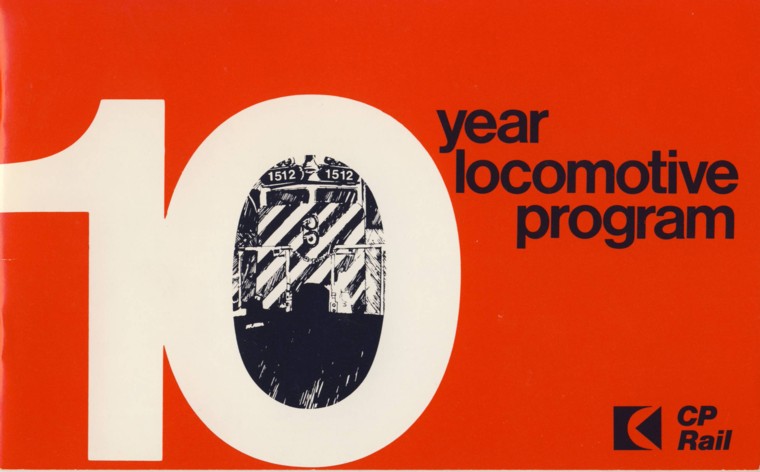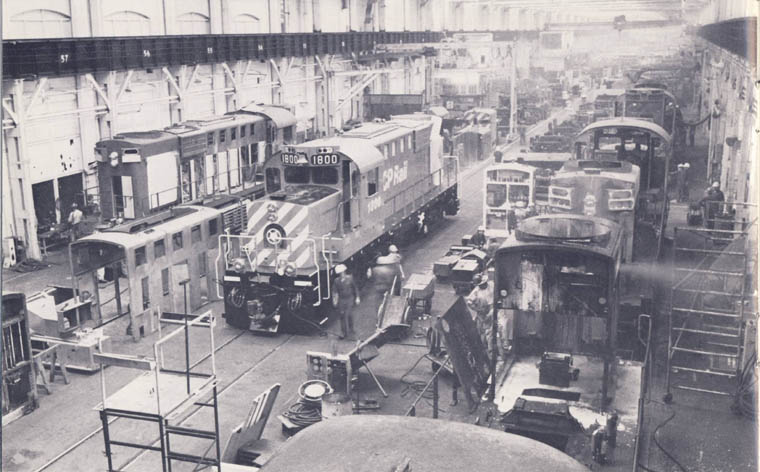|
|
|
CP Rail Ten Year Locomotive Program
R.L.Kennedy


1800 first RS-18 just finished its remanufacturing in
Angus Shops where steam locomotives once reigned supreme.
CP Rail, in 1980 began a long-range project identified as
their " 10-Year Locomotive Program ", a $200 million undertaking
to revitalize its motive power roster by replacing old, obsolete diesel
locomotives with newer units rebuilt and modified, including road switchers
adapted for yard use only.
Essential to this revitalization was the elimination of all old and very
expensive to maintain obsolete models, and this was a major feature of
the program. Alco/MLW 539 model prime mover (diesel engine) equipped units
dating back to the beginning of CPR diesel operations in 1943, (production
of which ceased back in 1958), and totaling nearly 200 units remained
in daily around-the-clock operation. These were 660 HP S3, 510, S11 models
(6500, 6600) and 1000 HP S2 & S4 (7000,7100's). However, aging steel
was suffering from corrosion and metal fatigue claimed components, while
deteriorating electrical insulation added to the overall problem. Parts
availability and cost was a problem also. This connected with the necessary
increase in shop time and resultant decrease in availability had combined
to make it very expensive to keep these engines in service. Major increases
in car capacity, train size and tonnage over the years had added to the
burden on these small units. Combined with the fact that while CP Rail
had in recent years purchased hundreds of high-horsepower six-axle units
for road service, no new yard engines had been bought since 1960! This
lack of newer, more powerful yard switchers had caught up with the present,
resulting in a critical situation. All of these units were to be retired,
to be replaced by small and medium size road switchers modified for yard
service only. These replacements were the 1000 and 1200 HP BLU (Branch
Line Units), and the GP7 and GP9 Road switchers. The GMD SW1200RS (8100)
units were intended from time of purchase to eventually replace older
yard switchers.
Similarly, early model road switchers dating from 1952 and having been
subjected to more strenuous main line work, were likewise becoming less
able to cope with the traffic requirements due to their advancing age
and the more demanding conditions existing in present day road operations,
for just as yard work had outgrown the old switchers, so too had much
of the road work outgrown that which could effectively be handled by these
1500 and 1750 HP units. Most of the oldest ones (GP7) had in recent years
been restricted to yard service; still they were suffering with problems
from aging wiring that must be completely replaced. Simply stated, time
had caught up with them, and in spite of regular overhauls carried out
over the years, a complete rebuilding had become a necessity. The slightly
newer GP9's were close behind. Thus the decision to completely rebuild
these units and modify them for use only as yard switchers not only solved
the problem of having to find replacements for the obsolete yard units,
their removal from road service opened the way for their replacement by
brand new units of the latest design and better capable of doing the required
job.
It should be noted that road power had long been used for heavy yard work,
especially transfers. This had accelerated in recent years due to the
lack of new and more powerful switchers being acquired. The small road
switchers (BLU) had already become defacto yard engines, most not actually
in yards were on local jobs such as road switcher assignments with only
a small number still doing road work.
In many cases 3000HP six-axle Road Freight units can be used to better
perform work previously done by smaller units. However, many trains due
to the nature of the work they perform such as switching on route still
require a road switcher type unit. Other trains must have 4-axle units
due to track and bridge restrictions. Thus the decision to rebuild the
MLW 1800 HP RS-18 units as road switchers, these units had proven themselves
to be real workhorses. They were considered not technically suited for
yard service; it being felt their 4-stroke cycle engine better used in
road service. Also, GMD 2250HP and MLW 2400HP Road Freight units were
to be modified to Road Switcher units to supplement the pool of these
units. These last two type of units were originally designed by their
builders as road switchers. In addition, new 2000 HP GMD Road Switchers
were to be added to the roster to fill the void left by the removal of
the GP9 units.
Another part of the program was the continued retirement of obsolete 244-engined
Alco/MLW units; 1500HP RS-2 and 1600HP RS-3 & RS-10 models. All A
& B units were previously retired. All CLC/FM units (A, B & RS)
were long ago retired as being obsolete, as were the tiny CLC Hydraulic
Switchers and the Baldwin units (RS and SW). Both of these builders had
ceased production many years ago. Also to be retired were the last of
the GMD A & B units, with engines identical to the GP7 units and similar
in age and condition. Additionally, their car body design ("covered
wagon"), made them less flexible in use.
Rebuild work would of course include a major overhaul, using newer 645
model parts in GM 567 engines, but more extensive work was carried out
including replacement of all power and control wiring. This rewiring not
only replaced aging trouble prone wiring with deteriorating insulation,
thus eliminating failures and fire hazards, it at the same time provided
units with wiring of current standards. It also saw traction motor power
cables removed to the underside of the GP units as a means of reducing
damage from fire. New design electrical cabinet apparatus and other improvements.
Removal of the parallel contactors (no final transition) restricted yard
units to 35 mph. This not only reduced maintenance costs, it ensured the
units would remain where they belong - in the yard, and not pressed into
road service during times of power shortages. Since yard service is less
strenuous, this will prolong their life. It is high RPM wide-open running
that is hardest on diesels. GP7 units still having 567B engine block got
a 567BC block from retired A & B units. New-style steps and uncoupling
levers were applied. Footboards were retained on yard and road switcher
units since they are required by the Collective Agreement (union). Dynamic
braking was removed from GP9 yard units, as it was not required. The most
noticeable modification was the retrofitting of a low-nose short hood
(chop nose) to those models built with a high short end (GP7, GP9, RS-18,
RSD-17), to improve visibility for the engineer. Many units were renumbered
as rebuilt, sometimes using horsepower related number series.
A few existing yard switchers were kept; these were all of the GMD units,
SW9, SW8 and SW900, which were the only other diesels on the roster. CP
Rail did not buy any MLW 251 engine yard switchers (only the 1000 HP BLU)
as did CNR and other railways. These units were equipped with roller bearing
trucks. The small quantity of 800/900 HP switchers found work on less
demanding jobs. The six SW9 1200HP switchers (7400's) also received standard
M.U. replacing existing M.U.
There were a few exceptions to all of this to allow for specific cases.
The 6 light-weight MLW RS-23 BLU (8013-8018) were retained as road switchers
for continued use on light trackage out of Sutherland, Saskatchewan. They
had roller bearings applied, being the only road units with friction bearings.
Twelve SW1200RS (8100's) were retained as road switchers for continued
use on subsidiary railways, Dominion Atlantic, and former CP Electric
Lines, Grand River Ry. and Lake Erie & Northern. Five GP9 units already
rebuilt were retained as road switchers, renumbered 8200-8204. They already
had chop-nose modification.
Air brake system modernization was not originally included in the rebuild
program, but began later. Details on Features page.
What resulted from all of this was a least cost solution to the yard switcher
problem.

Hail! Hail! The gang's all here! 1868 last RS-18 rebuilt
8/21/1969
Roster
Features on units
|
|
